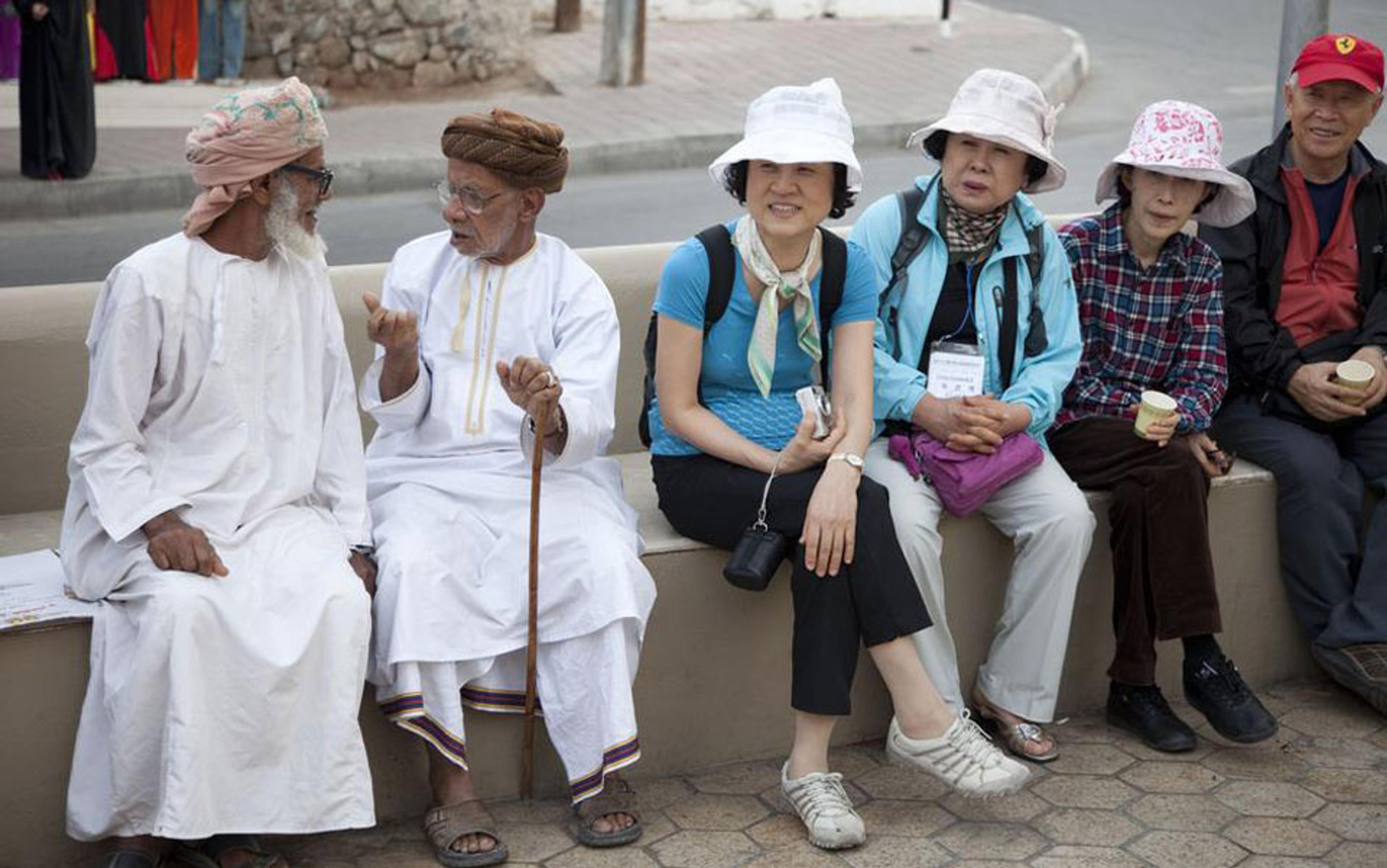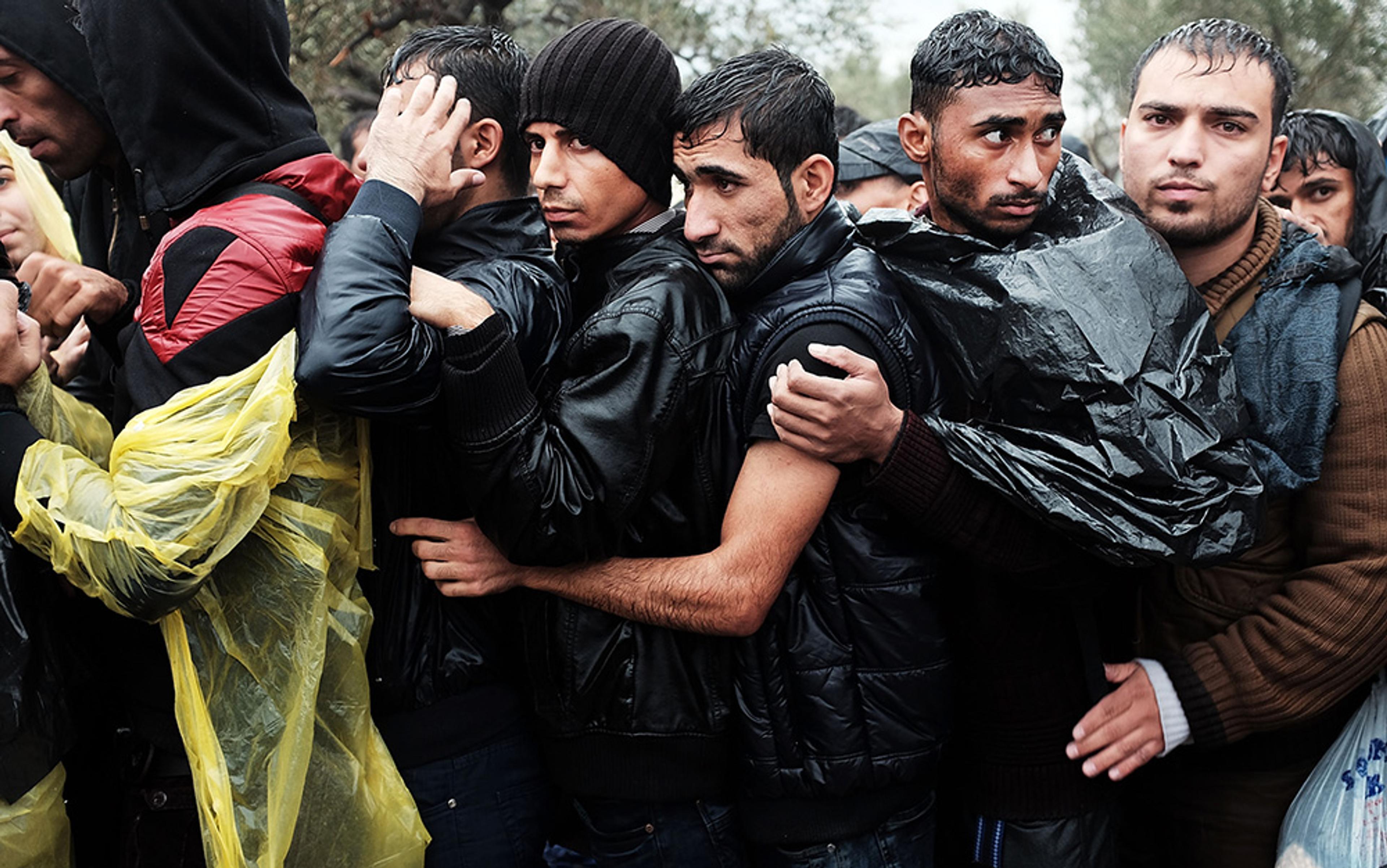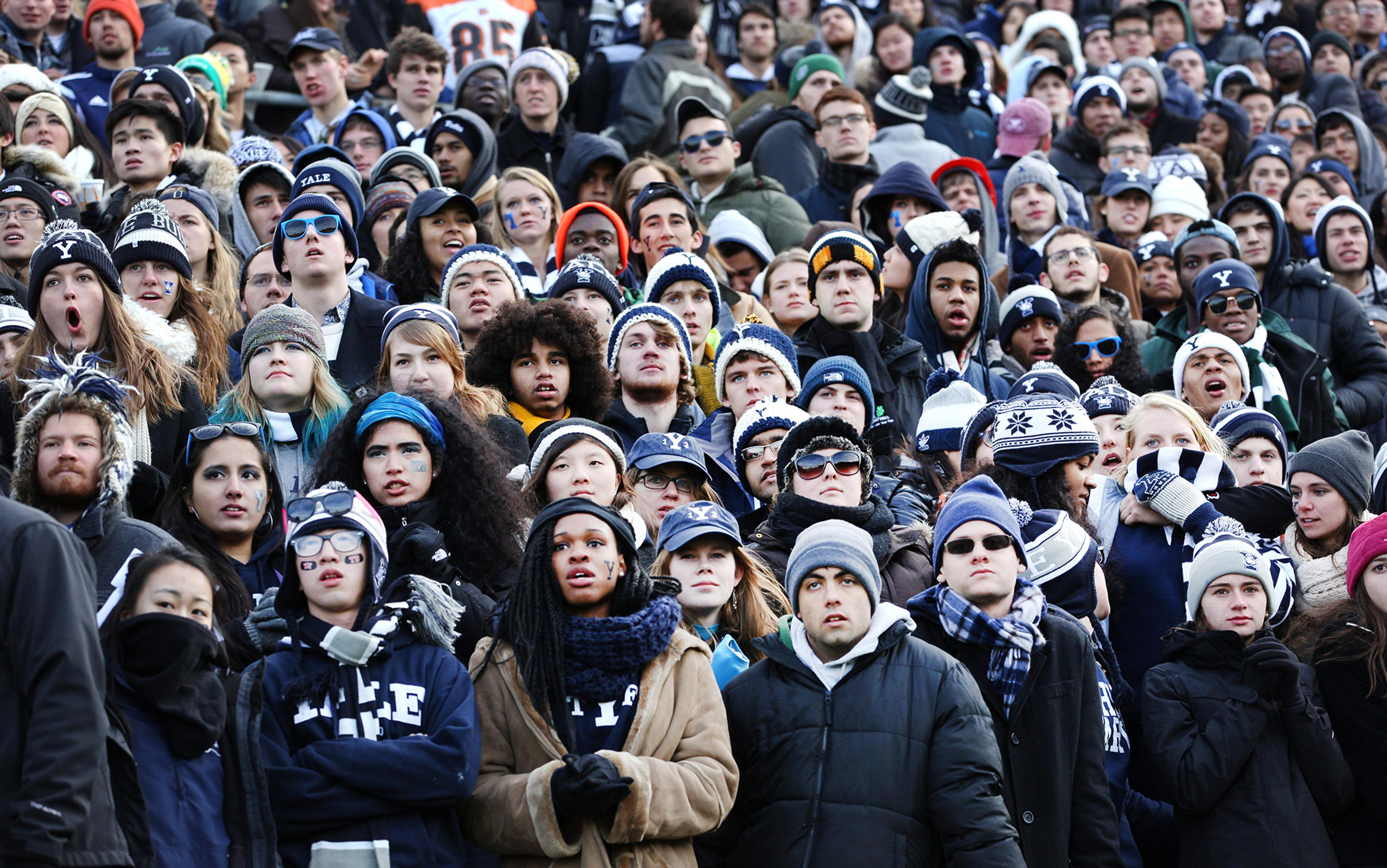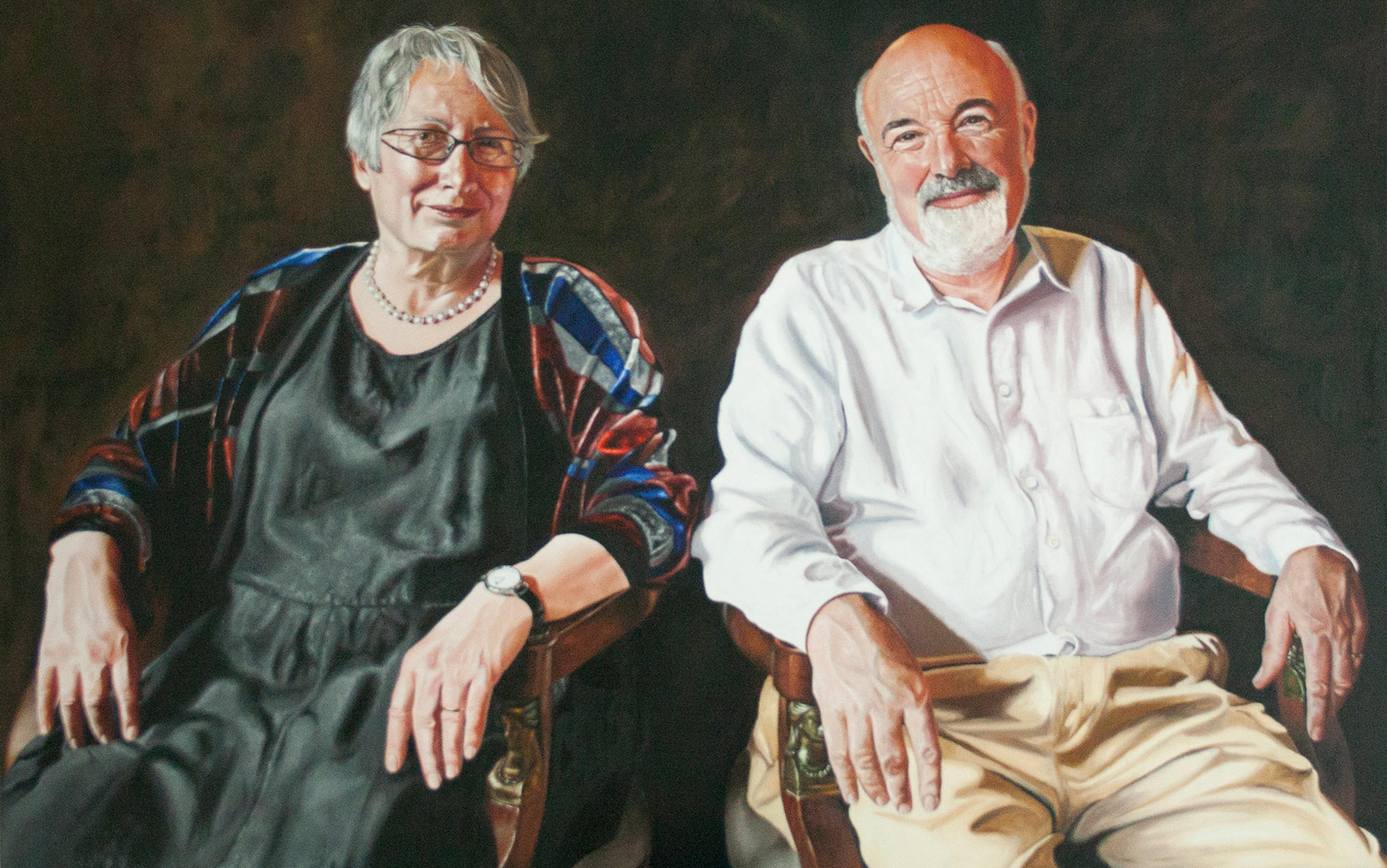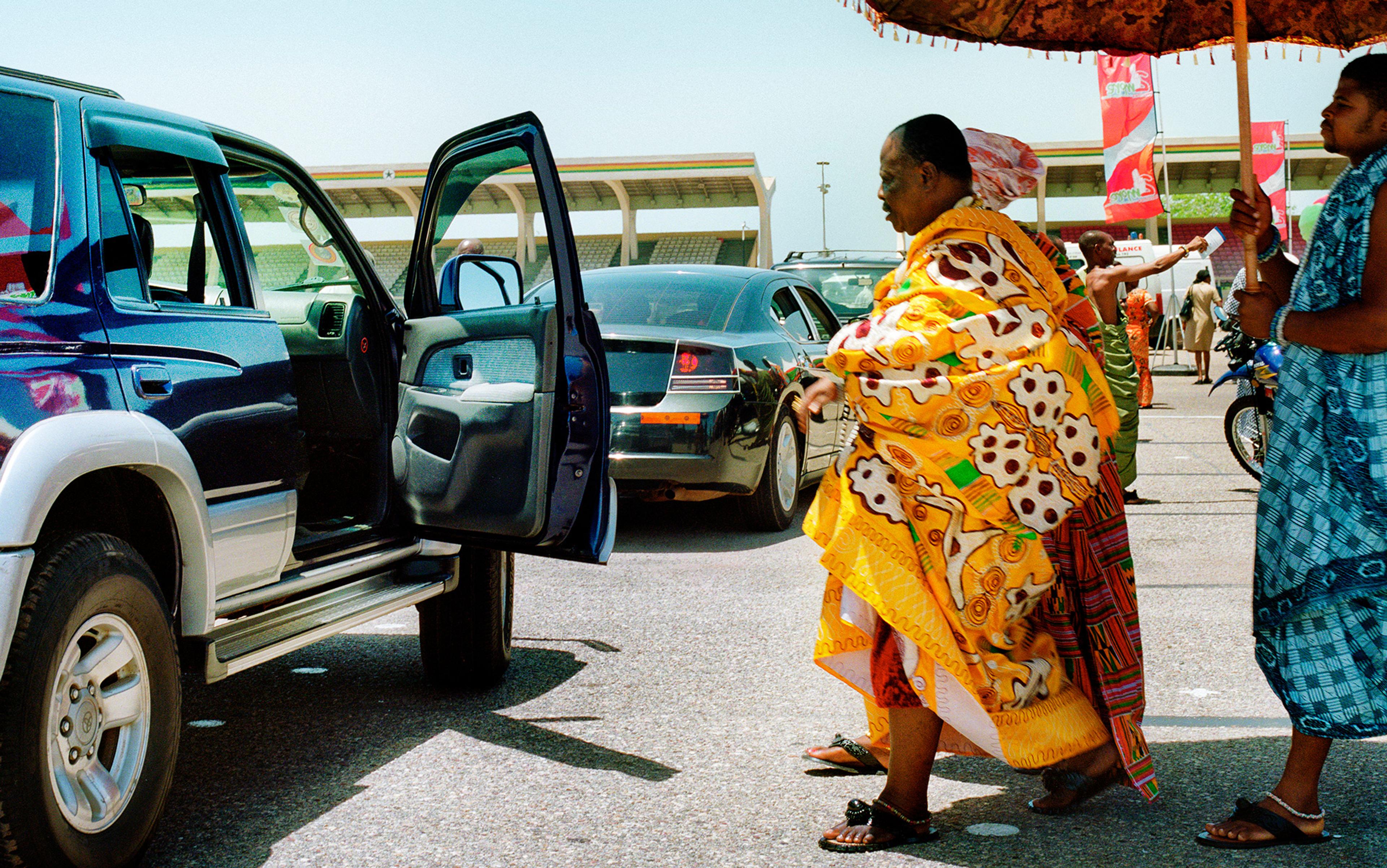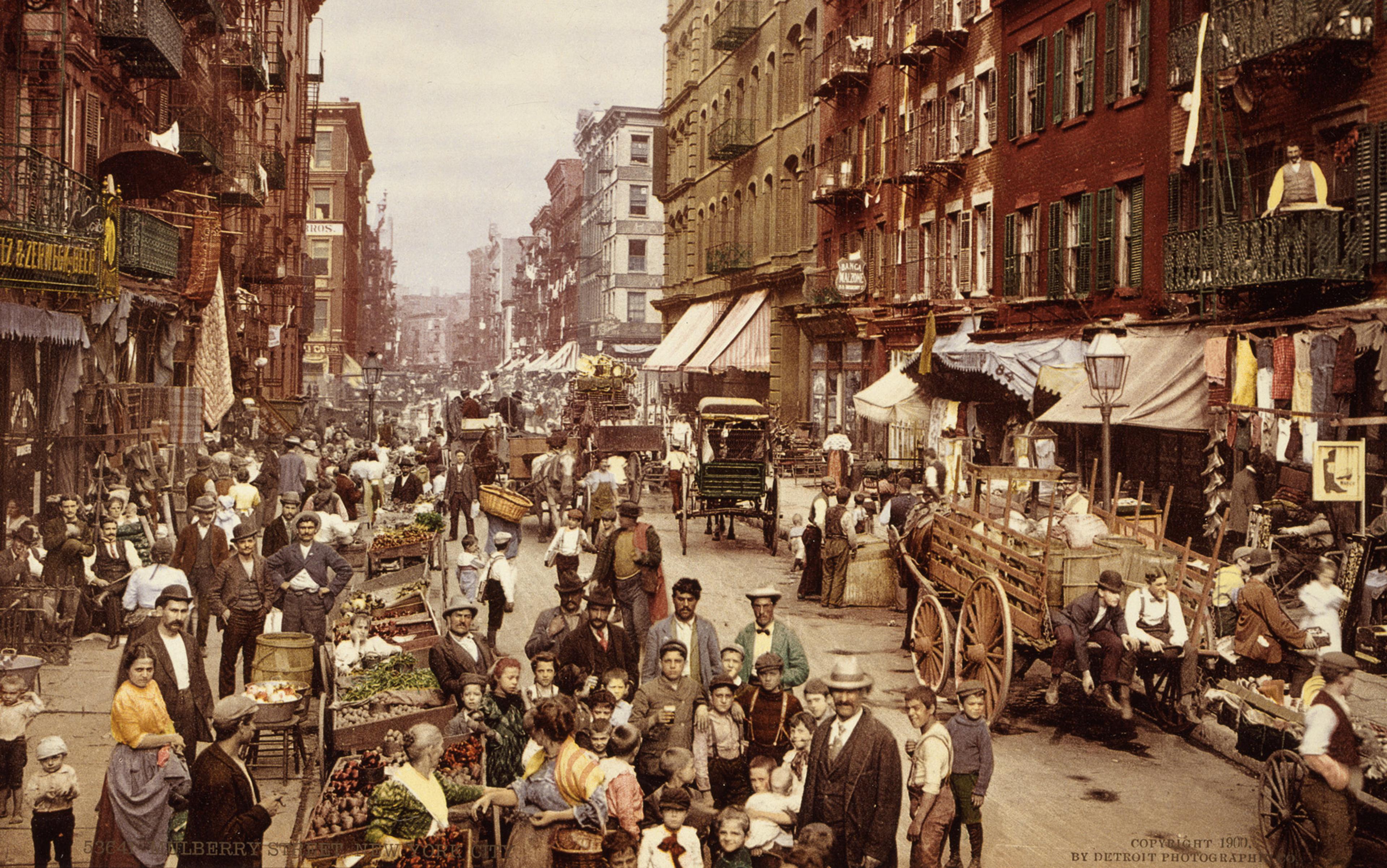We come into the world with open minds, ready to tune in to whatever language or culture surrounds us. But as we lock on to the strongest signals, the others become less distinct. As our sense of ‘us’ develops, our sense of ‘them’ degrades.
This seems to happen in infancy — before speech, stories or stereotypes. Of course, a baby cannot say that a face is different from one it has seen already. But its awareness can be inferred if it pays the new face more attention, for instance by looking at it for longer. When white babies in a Sheffield hospital were shown photos of students from visibly different ethnic backgrounds — white European, Middle Eastern, African, and Chinese — those aged three months showed that they could distinguish individuals in all the ethnic groups. Six months later, that ability would be gone. White babies aged nine months could differentiate only white individuals. Apparently the others all looked alike to them.
New-born babies gaze with equal attention at faces regardless of ethnic appearance, but by three months they prefer looking at faces from their own ethnic group. As their ability to organise their impressions develops, they focus on the kind of faces they see most often. If they tend to see both black and white faces, as in the case of Ethiopian babies who were studied while their migrant families waited to be housed in Israel, they might show no preference between the two. But if the faces floating above them are predominantly of one ethnic appearance, they are likely to build models in their minds based on its characteristic contours and tones.
These findings are unsettling. They suggest that a sense of ‘us and them’, with its accompanying biases, can emerge from vital processes that are not directly concerned with sorting people into in-groups and out-groups. Human beings are social by nature and obligation. Even loners born under a wandering star depend upon others to raise them until they are sturdy enough to wander off. And so an infant’s need to read and recognise faces is more pressing than its need to stand or speak. To recognise people and understand their expressions, it needs to build mental models of faces that it can compare with those it sees. During its first nine months, an infant seems to refine its models by narrowing its focus. In the process, it loses its ability to recognise less familiar-looking people as individuals.
It’s all too easy to see how this can play out. Infants lose the capacity to distinguish individuals regardless of race (in the sense of visible difference); then they gain the capacity to absorb prejudices; and they end up the kind of adults who say ‘They all look the same to me’ as an expression of disdain rather than a statement about perceptual shortcomings. Even without factoring in prejudice, it affirms the lesson on which so much of human history seems to insist: that sympathy for some entails the exclusion of others.
The idea of ‘us and them’ was crystallised in the 1906 book Folkways by the American sociologist William Graham Sumner. In his vision, it wasn’t just ‘us and them’ but ‘us versus them’. ‘The insiders in a we-group are in a relation of peace, order, law, government, and industry, to each other. Their relation to all outsiders, or others-groups, is one of war and plunder, except so far as agreements have modified it,’ he wrote. For Sumner, these relations demanded each other: ‘Loyalty to the group, sacrifice for it, hatred and contempt for outsiders, brotherhood within, warlikeness without — all grow together, common products of the same situation.’
He introduced the term ‘ethnocentrism’ to describe ‘this view of things’ in which one’s own group is ‘the centre of everything, and all others are scaled and rated with reference to it’. The term included the tendency for groups to regard others as less than fully human: ‘As a rule it is found that nature peoples call themselves “men.” Others are something else — perhaps not defined — but not real men.’ Sumner saw ethnocentrism everywhere, from Papuan villages in New Guinea ‘kept separate by hostility, cannibalism, head hunting, and divergences of language and religion’, to the great powers, each of which ‘regards itself as the leader of civilisation, the best, the freest, and the wisest, and all others as inferior’. Whether they wielded stone axes, like the Papuans who were still isolated from outside influence by the New Guinea highlands, whether they built ‘dreadnought’ battleships, as the great powers were racing to do, humans would always conjure up an Other to threaten with their weapons.
Around the same time, a similar sense of inevitability provided the English writer GK Chesterton with the founding assumption for his novel The Napoleon of Notting Hill. Published in 1904, it is set 80 years later but, unlike George Orwell’s 1984, it depicts a country that has turned its back on radical modernisation. A new king is appointed at random, and on a whim he decides to impose a cod mythology of his own devising upon the districts of London, each of which is to have ‘a banner, a coat-of-arms, and, if convenient, a gathering cry’, as well as a surrounding wall with gates to be closed at sunset. One crazed soul in Notting Hill takes him seriously and raises the banner of the Red Lion — a pub the king used to frequent — against a plan to build a road through the neighbourhood. The emblems bestowed by the king in jest became symbols to live or die for: London Balkanises into a throng of jostling statelets — Bayswater, Shepherd’s Bush, North Kensington — that send their halberdiers and spearmen to a pitched battle in Kensington Gardens.
The king’s caprice anticipates a strategy introduced by psychologists half a century later. In a distilled form, it is still the basis of games used to investigate the ins and outs of groups. In the summer of 1954, the social psychologist Muzafer Sherif and his colleagues at the University of Oklahoma took two groups of 11 boys, aged 11, to a scout campsite in Robbers Cave State Park in southeast Oklahoma. At first, the two groups were unaware of each other’s existence. Before long, they had given themselves names — the ‘Rattlers’ and the ‘Eagles’ — and flags, and begun an informal rivalry.
People will coalesce into parochial groups at the drop of a hat, no matter how tiny, esoteric or spurious their differences
Then the researchers inaugurated a tournament, with medals and knives as prizes. The Rattlers decided to put flags on the swimming hole and other sites they claimed as theirs. When they planted their flag on the baseball field, the Eagles tore it down and burned it. A series of tit-for-tat cabin raids ensued. At one point, the Eagles filled socks with stones to defend themselves. Having stoked the conflict to the verge of potentially lethal violence, the researchers then induced co-operation by getting the two groups to work together for a common goal.
William Golding’s The Lord of the Flies was published a few months later. It has the same demonstrative quality: both exercises leave us with the sinking feeling that they have dramatised something we already knew about human nature, and that their authors knew their conclusions in advance. In structure rather than mood, however, the Robbers Cave experiment has more in common with Chesterton’s novel. The researchers and the king both set up groups that then vied with each other for symbols of prestige provided by the manipulating authorities — the king’s banners and the psychologists’ medals. And crucially, the contests were over territory and goods as well as prestige. Although the ‘free cities’ of Chesterton’s London ended up fighting over local honour, the author took care to establish a material basis for antagonism in the original conflict over the plan to build a road through Notting Hill. The Rattlers and the Eagles coveted the knives that the experimenters dangled before them, out there in psychology’s Wild West. Sumner himself believed that tensions between groups arose from contests over resources — that they were about something more than group identity itself.
That point of view left the psychologist Henri Tajfel with the ‘nagging feeling that it omits an important part of the story’. In the early 1970s, he set out to see just how little it took to create devotion to an in-group and antipathy towards an out-group. Working at the University of Bristol, he gave local teenage boys a meaningless test, estimating numbers of dots shown on a screen. The boys were then assigned at random to two groups, designated arbitrarily as ‘underestimators’ and ‘overestimators’. Asked to give each other cash rewards or penalties, they favoured members of their own group, displaying gratuitous spite towards the other group by declining to give rewards even when it didn’t reduce the amount that went to their own.
Setting up ‘minimal groups’ like these became standard procedure for researchers interested in what makes in-groups tick. The findings leave no room for doubt: people will coalesce into parochial groups at the drop of a hat, no matter how arbitrary, tiny, vague, esoteric or spurious the differences between them. Rewards, prizes or turf wars will bring the biases to light, but they aren’t necessary. In-group love and bias against out-groups can arise even if nothing at all is at stake.
They can even prevail among populations of simulated agents in a computer model. In a simulation run in 2006 by Robert Axelrod, a pioneer of computerised co-operation games, and his colleague at the University of Michigan at Ann Arbor, Ross Hammond, agents were assigned notional ‘colours’. The winners turned out to be the ones that opted to co-operate only with players of their own colour. They reproduced while others died out: after 1,900 runs of the game, three quarters of the players were ‘ethnocentric’. The population had evolved through selection. In the natural world, this selective process might have unfolded long before our own species evolved. Rhesus macaque monkeys can distinguish the faces of members of their own group from those of outsiders, and they keep a closer eye on the latter. The last ancestor shared by rhesus macaques and humans lived 25 to 30 million years ago.
With in-groups just waiting to happen, the level of expenditure invested in group identity — religious rituals, military parades, team sports matches, planting a flag on the moon — might seem surprising. Clearly it is not a mere threshold-crossing effort, like heating a solution of chemicals just enough to make them react. Rather, it is a way to make the most of the apparently limitless opportunities that the in-grouping reflex so readily offers. The investment goes where the dividends are sure to multiply, reinforcing the configurations with most power. Commonly that means nations, and on the world scale, the greatest success so far has been the United States. It has pulled away so far from its rivals over the past century that it is now the only power in a position to regard itself in Sumner’s words as ‘the leader of civilisation, the best, the freest, and the wisest’ — provoking resentment from lesser nations and self-consciously obscene massacres by less clearly defined groups. In New Guinea, meanwhile, conflict between villages remains endemic, and the weaponry now includes American assault rifles.
Some people look at this state of affairs and see the engine of human progress at work. Groups that work well together outcompete their rivals, and when competition becomes conflict, it drives technological innovation. Germany developed V2 rockets to fire at Britain, but the Allies defeated Germany, and America captured the rockets, using them to develop its own missiles for its nuclear arms race with the Soviet Union. The two superpowers then applied their knowledge of rocketry to compete in a space race, which ended with the Stars and Stripes planted in the dust of the Moon’s Sea of Tranquillity.
This is not principally a vision of technological progress, however, but of moral evolution. Charles Darwin outlined the logic in The Descent of Man (1871):
A tribe including many members who, from possessing in a high degree the spirit of patriotism, fidelity, obedience, courage, and sympathy, were always ready to aid one another, and to sacrifice themselves for the common good, would be victorious over most other tribes; and this would be natural selection. At all times throughout the world tribes have supplanted other tribes; and as morality is one important element in their success, the standard of morality and the number of well-endowed men will thus everywhere tend to rise and increase.
The problem, of course, is that this is the bipolar morality modelled by the agents in the computer simulation: help those who are like yourself; harm the rest.
The economists Samuel Bowles and Herbert Gintis, influential theorists of co-operation, call this ‘parochial altruism’ in A Cooperative Species (2011). Their computer simulations and analyses of the limited data on prehistoric warfare have persuaded them that war might have spread altruism through humankind, playing ‘a critical role in the evolution of this particular co-operative species’. They protest that they ‘initially recoiled at this unpleasant and surprising conclusion’. Nevertheless, in a commentary for the journal Science in May 2012, Bowles hails conflict as ‘a midwife for humanity’s most cherished values and institutions: among them democracy, the rule of law, and a propensity to help others and to abhor injustice.
In this narrative, nation states conquered the motley sovereign entities of Europe, China and elsewhere, demolishing city walls and spreading the co-operative virtues on which their military superiority was based — willingness to fight for one’s country, for instance, and respect for property rights. Later on, groupings arose within these states and their colonies that aspired to universality, as opposed to the divisions imposed by the political elites. Bowles’s examples include democracy movements, trade unions and the opposition to apartheid in South Africa. Human history is the history of group rivalries, and of new groups emerging to develop society’s forces of co-operation through further struggle. Bowles is a politically minded economist, and the distinctly Marxian dynamic of his view of history recalls his left-wing back pages.
On this issue, Bowles finds himself grouped with the biologist Edward O Wilson, whose interest in communism is confined to his celebrated studies of ant societies. In The Social Conquest of Earth (2012), Wilson fervently insists on humankind’s fundamentally ‘tribal’ nature. ‘To form groups, drawing visceral comfort and pride from familiar fellowships, and to defend the group enthusiastically against rival groups — these are among the absolute universals of human nature and hence of culture,’ he says. But defence, being a forced choice, doesn’t naturally inspire enthusiasm; attack, on the other hand, might do. In that case, perhaps ‘defend’ here should be taken in the self-exculpatory sense in which the Ministry of War becomes the Ministry of Defence. Read like that, Wilson’s statement testifies to the strong version of the tension between us and them: it echoes Sumner’s view that love for one’s own group induces active hostility towards others. According to Wilson, the human condition is one of ‘unavoidable and perpetual war’.
Was this the way in which people living in a modern, civilised state ought to behave?
The theoretical basis for his image of war is the balance between two levels of natural selection. In the 1960s, evolutionary biologists invigorated their discipline by rejecting the idea that natural selection worked for the good of groups. Selection acting on individuals would always be stronger than selection on groups, they calculated; altruistic tendencies that benefited groups would be undermined by selfish individuals, who would multiply at the altruists’ expense. In recent years, however, group selection has made something of a comeback in certain quarters. Its advocates, led by Wilson, argue that selection at the level of the group can sometimes outweigh selection at lower levels, particularly in our own species. And it would produce different results. At the group level, it would tend to encourage ‘honour, virtue and loyalty’, while pressures acting on individuals elicited ‘selfishness, cowardice and hypocrisy’.
These ideas have caught the attention of a wider audience, one that never felt comfortable with evolutionary perspectives based on selfish genes and sought alternatives that seemed to put altruism first. The group vision even promises to quell the heart-of-darkness horror that is stirred up when neighbours slaughter neighbours and supposedly ‘ancient hatreds’ appear irresistible; it suggests that group conflict is both humankind’s original sin and its redemption.
However, as far as the psychologist Steven Pinker is concerned, the idea is a mess: ‘the concept of group selection is making a shambles of the application of evolutionary biology to human psychology’. Leading a discussion on the Edge website in June 2012, he complained that Wilson’s ideas had ‘led commentators to equate human goodness with prowess in tribal competition — as if the only reason we feel compassion for a lame puppy is that it helped our ancestors massacre the villagers across the river’.
Many people were unsettled by the outbreaks of public celebration in the US that followed the shooting of Osama bin Laden. The psychologist Jonathan Haidt reassured them, in a New York Times op-ed piece in May 2011, that revelling in the death of an enemy was a ‘good, healthy and even altruistic’ expression of group feeling. To think otherwise was to confuse what was right for individuals with what was right for groups. The two were different, and the reason why lay in that distinction between levels that the new wave of group selection theorists had newly reaffirmed, defying all those biologists who supposedly spent the past 50 years telling us that evolution made us selfish. Of course, it would be more accurate to say that those biologists had spent their time working out just why selfish genes were so abundantly co-operative, but this factional dispute is about moral associations as well as scientific authority.
Like EO Wilson, Haidt suggested that human psychology embodies a contradiction between selfishness, evolved through competition between individuals, and co-operative instincts, evolved through competition between groups. These two levels, he suggested, were what constituted the sociologist Émile Durkheim’s ‘Homo duplex’, the twofold man. The celebrations of bin Laden’s killing were communal ecstasies, uniting the group by dissolving the sense of self — something Durkheim called ‘collective effervescence’. (The enthusiasm that Wilson associates with group defence is a related emotion.)
But was this the way in which people living in a modern, post-tribal, civilised state ought to behave? ‘When celebrants chanted “USA! USA!” and sang God Bless America, were they not displaying a hateful “us versus them” mindset?’ Haidt asked. As evidence that they were not, he cited a study by a psychologist who found that people flew the Stars and Stripes after 9/11 to show solidarity with their fellow Americans, not to express hostility to out-groups. They were patriots who loved their country, not nationalists who wanted it to dominate others.
Of course, that’s a slippery distinction when it comes to national sentiments. Love of one’s country is bound up with pride in it; and in powerful nations pride encourages the belief that one’s own country is the best, freest and wisest, which induces feelings of hostility towards countries that fail to respect its superiority. Nevertheless, the relationship between in-group love and out-group hate can be probed by experiments. The question of whether they are two sides of the same coin is now at the centre of research into the psychology of us and them.
Sumner had seen the one as the product of the other, believing that harmony within groups was established by conflict between them. The assumption that in-group harmony and out-group conflict were inseparable prevailed throughout the 20th century. One notable dissenter was the psychologist Gordon Allport, who argued in the mid-1950s that, while we need out-groups in order to recognise in-groups, we do not need to hate them in order to love our own. In-groups emerge first in our minds, as we form attachments to those around us; out-groups are secondary. Furthermore, although in-group love inevitably produces favouritism, it does not necessarily produce aggression, spite or even dislike.
Signs of affiliation help to turn a melee of floating faces and animated bodies into meaningful patterns
Oxytocin illustrates the point. In recent years, this neuropeptide has acquired an aura similar to that enjoyed by ecstasy at the high dawn of rave culture. It is hyped as the ‘love peptide’, softening people into togetherness, and as the ‘moral molecule’, making them treat each other as they should. Yet its morality appears to stop at the boundaries of the in-group. In a series of studies run by the psychologist Carsten de Dreu and his colleagues at the University of Amsterdam during 2010-2012, oxytocin emerged as a promoter of ethnocentrism, in-group favouritism and escalating group conflict. When Dutch men were dosed with either oxytocin or a placebo, the ones on oxytocin associated emotions such as hope or embarrassment more strongly with a ‘typical’ Dutch person than with a ‘typical’ Muslim. These emotions are commonly regarded as uniquely human, so the implication was that oxytocin encouraged the men to see their own group as more human than the other. However, further research suggests that the bias developed because oxytocin affected how they saw ‘us’, but not how they saw ‘them’. It induced them to see a greater emotional range in their own group, while having no effect on how they perceived the other’s emotional hinterland.
They were also presented with the trolley dilemma, an imaginary situation in which subjects are required to decide whether it would be right to cause someone’s death in order to save the lives of others. Under the influence of oxytocin, they were less willing to sacrifice a man named Maarten — but they were no more willing to sacrifice a man named Mohammed. Oxytocin had increased their concern for their imaginary fellow Dutchman. It had not made them more indifferent to the fate of the Muslim.
Oxytocin induced a similar pattern of increased in-group favouritism without increased out-group hostility when subjects (again male) were put into groups and given €10 each. They were told they could divide it between themselves and two funds. Both funds benefited their fellow group members — 50 cents for every euro contributed — but one of them also deducted cash from members of other groups. Without oxytocin, 20 per cent of players gave more to the in-group-only fund than they kept for themselves or gave to the spiteful fund. However, under the influence of oxytocin, the percentage of ‘in-group lovers’ trebled. Meanwhile, the percentage of ‘out-group haters’ hardly changed.
All the same, whether it arises from favouritism or spite, bias can provoke resentment that leads to conflict. And when that happens, oxytocin can up the ante. Invited to choose who they wanted on their team in a cash-allocation game, men on oxytocin picked more threatening-looking faces than those not dosed with the ‘cuddle chemical’. It’s a ‘male warrior’ thing, said another Amsterdam researcher, Mark van Vugt; women get less worked up on behalf of their in-groups when they play games like these.
The uncoupling of in-group love from out-group hate has implications for whether contact between people of different cultures brings them together or pushes them apart, as the controversial political scientist Robert Putnam noted in a 2007 lecture entitled ‘E Pluribus Unum’. If attitudes within groups do not determine attitudes between them, it is logically possible that diversity reduces solidarity both within them and between them. Putnam claimed that, across America, diversity had undermined trust and social cohesion as a whole: ‘Americans distrust not merely people who do not look like them, but even people who do.’ In diverse settings, he found that people ‘hunker down’ and withdraw from each other.
His argument sent researchers into the field across North America and Europe. Their findings mostly supported Putnam’s case. Nevertheless, some studies found that diversity did in fact promote trust and cohesion in cases where people from different backgrounds had a meaningful degree of contact with each other. Perhaps that shouldn’t be surprising: after all, trust is an expectation about how others will behave. If you share their culture, norms and values, you might be confident in your ability to predict their behaviour even without having anything to do with them. If you don’t, you just have to get to know them personally.
The kernel of the us-them problem is the question of why the tiniest and most apparently inconsequential differences are enough to trigger the group-forming reflex. One explanation is that small differences can be indicators of larger differences in culture, kinship and affiliation. Accents and quirks of speech, easily checked and hard to fake, can be giveaways, as the Bible tells us:
And the Gileadites took the passages of Jordan before the Ephraimites: and it was so, that when those Ephraimites which were escaped said, Let me go over; that the men of Gilead said unto him, Art thou an Ephraimite? If he said, Nay;
t
hen said they unto him, Say now Shibboleth: and he said Sibboleth: for he could not frame to pronounce it right. Then they took him, and slew him at the passages of Jordan: and there fell at that time of the Ephraimites forty and two thousand.
That chillingly precise casualty figure seems to suggest this is one passage of the Old Testament that can be taken literally.
The shibboleth was a test of who was on whose side; and that, according to the evolutionary psychologists Leda Cosmides, John Tooby and Ray Kurzban, is what group markers are really all about. Signs of affiliation help to turn a melee of floating faces and animated bodies into meaningful patterns. They let individuals understand who is with whom and what is going on. Humans are not simply social beings but political ones. From playgrounds to corridors of power, they are constantly forming, modifying, ending and generally complicating alliances. Stable cues that signal alliance, such as speech traits or styles of dress, offer regularities that help people orient themselves in the social whirl.
Race might be one such cue, but Cosmides, Tooby and Kurzban’s experiments from 2001 show that it does not necessarily carry the weight its salience as a social issue would suggest. People do indeed seem to categorise each other by race automatically. Even so, the experimenters were able to downgrade it as a category in a matter of minutes by using neutral colours as markers. When people were told that individuals wearing grey or yellow shirts belonged to two groups, they relied much more heavily on the shirts than the ethnic appearance of the wearers to decide which group they belonged to. Other researchers have reported that accent also trumps race. Young children choosing friends seem to prefer children of other races who speak with the same accent to children of the same race who speak with a different one.
Those American findings might seem familiar to people living in Britain, where the Union flag erased visible ethnic differences between the Olympic athletes of Team GB last summer, and young Londoners of all kinds of heritage share an accent peculiar to their singularly diverse city. Although people are hazy about what Britishness is, the vast majority of them no longer think it depends on race. At the same time, many of them mistrust Muslims and consider immigrants unwelcome. The great British in-group has reinvented both itself and its others. It is a much fairer nation than it was, inclusive to a degree unimaginable a generation or two ago. But in recomposing its coalitions, it inevitably sets up the potential for new biases and unfairness. Perhaps we simply have to accept that the relationship between us and them is always a work in progress.
